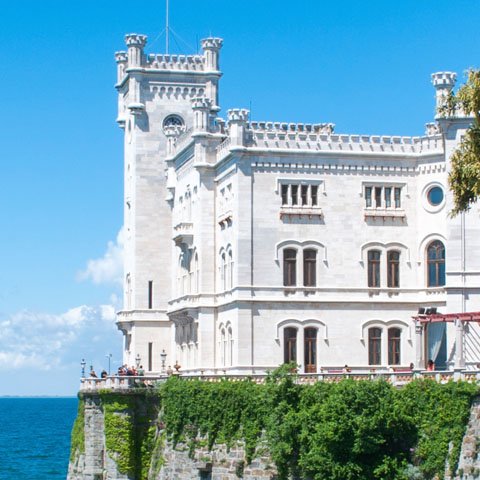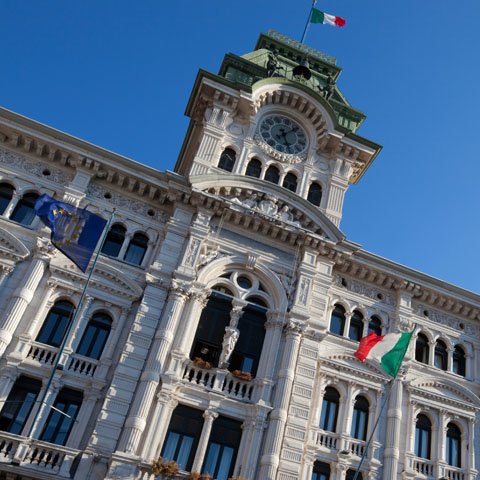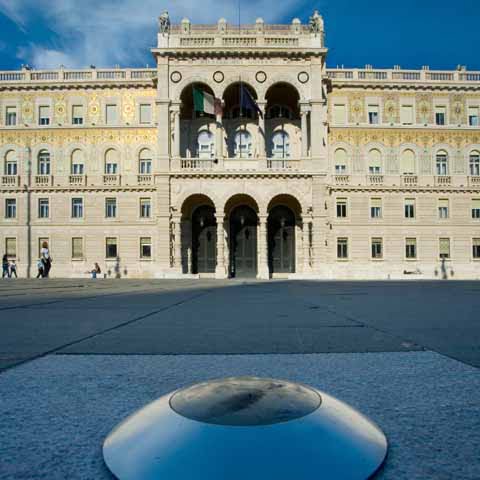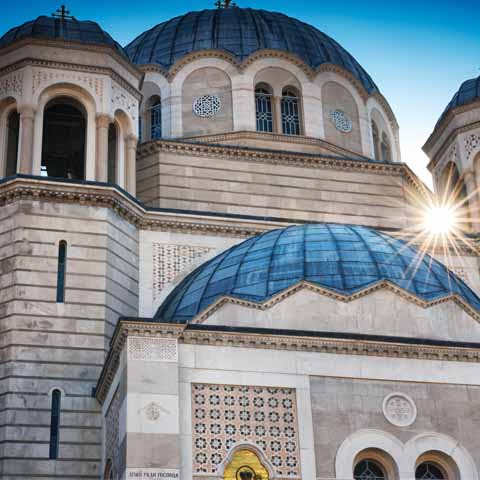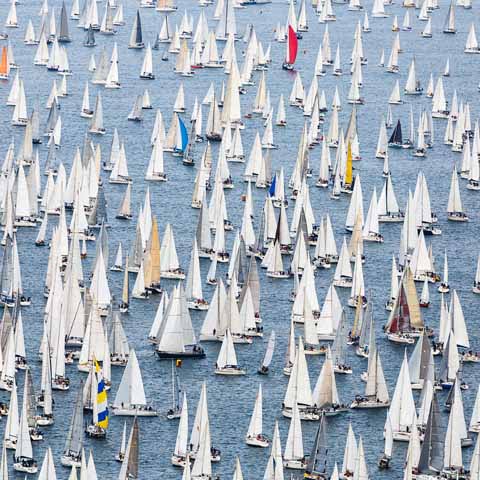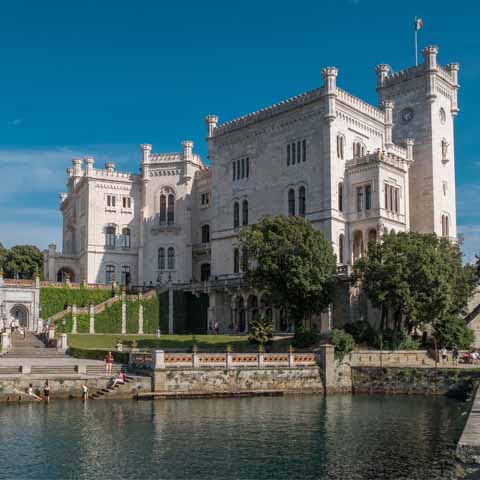Tucked into the far northeast corner of Italy in the region of Friuli Venezia Giulia, is the beautiful and thriving port city of Trieste.
Trieste is the capital of this autonomous region. With a population of more than two hundred thousand living in this busy commune that is estimated to be slightly under thirty-five square miles, the bustling city is a mesmerizing maze of buildings and narrow streets that often slope down toward the Gulf of Trieste.
Although originally a port and large city of the Habsburg Empire for several centuries, Trieste became part of Italy after World War I. Because of those ancient roots, much of the architecture of buildings and even local cafés can be largely reflective of the city’s Austro-Hungarian heritage.
Perhaps one of the most recognizable and well-known features of the city is Piazza Unità d’Italia. As one of the largest seaside piazze in all of Italy, the square is part of the town’s historic center. The square is bordered on three sides by gorgeous and stately Austrian-style buildings and on the fourth side by the sparkling blue expanse of the Adriatic Sea. Several architecturally impressive buildings such as the City Hall, Palazzo del Governo, Palazzo Pitteri, and Palazzo del Lloyd Triestino help form the square. The area is a hub of activity during most weekdays and offers visitors an up-close view of the famous Fountain of the Four Continents, as well as several statues found throughout.
Trieste faces the Gulf of Trieste and Adriatic Sea, both of which are a contributing factor to the port’s industry and success over the centuries. Sea vessels still travel those waters today and are guided by the Faro della Vittoria, one of the tallest lighthouses in the world located on the Gretta Hill at just over two hundred feet tall.
To many, the city of Trieste is a utopia and refuge for serious writers. For much of the nineteenth century and beyond, writers and poets have sought the atmosphere of a small café table facing the Adriatic Sea in hopes of being struck by inspiration. Some of the renowned writers inspired by Trieste include Italo Svevo, Sir Richard Francis Burton, Umberto Saba, James Joyce, and Jan Morris. Author James Joyce is credited with writing several notable twentieth century works during his time in Trieste, and possibly at a café by the water, which may be why a special plaque can be found at one of the seaside Trieste coffeehouses with a quote from him that reads, “I came here habitually.”
The city is home to the University of Trieste which was established in the early twentieth century and has grown to become a rather large educational institution with more than twenty thousand students and over one thousand professors. Also found in Trieste is the Scuola Internazionale Superiore di Studi Avanzati (SISSA) which is a leading graduate and post graduate school of physics, mathematics, and neuroscience. The city’s MIB School of Management Trieste is one of Italy’s top business schools.
While Trieste is officially a city of Italy, due to the city’s history, a number of languages can be heard here. Both Italian and a local dialect called Triestine are commonly spoken in more urban areas. In more rural and suburban areas, Slovene, German, and even Hungarian can be heard.
Transportation is well established getting to and around Trieste. When arriving and leaving Trieste, consider taking a boat to the port, taking a high-speed train, or flying via Trieste – Friuli Venezia Giulia Airport. As for touring and sightseeing in the city, think about taking a boat tour in the Gulf of Trieste, riding a bus, or even using the local tram.
GEOGRAPHY
The city of Trieste is built primarily into a mountainside, but the downtown or central hub of the city sits at the foot of it. Directly above the city is the Karst Plateau, which stretches from southwestern Slovenia to northeastern Italy where the Friuli Venezia Giulia region lies.
The city of Trieste opens up to the Gulf of Trieste which is part of the Adriatic Sea. There are not many beaches along this coast, with the coastline dropping sharply into the water in some places. The port is home to many sea vessels that form a crucial part of exports and imports for the region.
CLIMATE
The majority of Trieste’s coastline typically enjoys mild and pleasant temperatures and very little change between seasons. That said, this does not account for the northeasterly wind referred to as Bora.
The Bora is one of the most unique weather phenomena in the region. It is a dry and often cold north to northeast wind that comes off the Karst Plateau and whips through the city. The wind most often occurs in winter and can last for days, with wind speeds as high as eighty-seven miles per hour. In the dead of winter, the wind can make the temperature feel much colder than it actually is.
Because of the strength of the Bora when it blows through, it is not uncommon to find locals and visitors making their way through the city fighting the wind by clutching their clothes about them and hanging on to stationary objects to sturdy them. The wind is so strong, some buildings in Trieste have been known to put stones on the roofs to keep the wind from peeling back the roofing tiles.
WHEN IN TRIESTE
The Barcolana Regatta is one of the more exciting fall events in Trieste. The event is an international sailing regatta that happens annually on the second Sunday of October. The regatta is so globally renowned that it is one of the most crowded regattas in the world. The course is approximately fifteen miles, and although the finish line placement can fluctuate, the finish is often in the waters directly across from the Piazza Unità d’Italia. It is estimated that on average more than twenty-five thousand sailors enter the race and two hundred and fifty thousand spectators watch from the coastline.
A mere twenty minutes from the city of Trieste is Grotta Gigante. This giant cave is thought to be one of the largest tourist caves in the world. Located on the Italian side of the Trieste Karst, this cave contains a mesmerizing sampling of stalactites and stalagmites throughout. The main area of the cave is more than three hundred feet high and two hundred feet wide. The path can be steep, and good walking shoes are definitely recommended, but the experience is truly unparalleled.
The Northern Italian city of Trieste is defined by its varied cultural heritage. As one of Italy’s most important port cities and the capital of the Friuli Venezia Giulia region, Trieste offers a variety of interesting sights for travelers who are eager to venture outside of Italy’s most famous travel destinations.
Don't just see Italy, live it.
Your dream trip to Italy has never been closer
No more endlessly scrolling travel sites. Our travel experts will craft the perfect, one-of-a-kind trip just for you.

300+
DESTINATIONS
We offer more Italian destinations than any travel site. Do and see more with Trips 2 Italy.
1 (of a kind)
ITINERARIES
Because your dream trip to Italy should be designed for you, not for the masses.
100%
PEACE OF MIND
From flights and accommodations, to food and activities - we take care of every detail.
